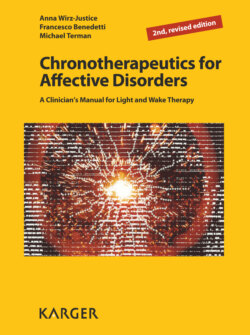Оглавление
M. Terman. Chronotherapeutics for Affective Disorders
Chronotherapeutics for. Affective Disorders
Contents
Foreword
Acknowledgements
List of Abbreviations
Introduction
1.1 Unmet Needs in the Treatment of Depression
1.2 Role of Biological Rhythms in Psychiatry
1.3 Principles of Circadian Timing
1.4 Principles of Sleep Regulation
1.5 Mood Level Varies with Time of Day and Duration of Wakefulness
1.6 Sleep Deprivation
1.7 How It All Began: Light Therapy for Seasonal Affective Disorder
1.8 Light Therapy – Beyond SAD
1.9 What Is Chronotherapeutics?
1.10 How Does Chronotherapeutics Work?
Individual Chronotherapeutic Elements: Light, Wake Therapy and Sleep Phase Advance
2.1 Efficacy of Bright Light Therapy for SAD
Research Precedent 1
2.2 Timing of Bright Light Therapy
2.3 Dawn (and Dusk) Simulation Therapy
2.4 Efficacy of Bright Light Therapy for Non-Seasonal Depression
Research Precedent 2
2.5 Dark Therapy
2.6 Wake Therapy
2.7 Phase Advance of the Sleep-Wake Cycle
2.8 Negative Air Ionisation
Research Precedent 3
Research Precedent 4
Integrative Chronotherapeutics: Combinations of Light, Wake Therapy and Sleep Phase Advance
3.1 A Note on Diagnostic Differences
3.2 Bright Light Augmentation of Antidepressant Drug Treatment
Research Precedent 5
Research Precedent 6
3.3 Wake Therapy Added to Medication
Research Precedent 7
Research Precedent 8
3.4 Wake and Light Therapy Added to Antidepressant Drugs or Mood Stabilisers
Research Precedent 9
3.5 Wake, Light, and Sleep Phase Advance Therapy
Research Precedent 10
Research Precedent 11
3.6 Repeated Wake Therapy
Inpatient Procedures
4.1 Response Assessment and Monitoring
4.2 Light Therapy Timing and Duration
Caveats
4.3 Exceptions to the Early Morning Light Rule for Bipolar 1 Disorder
4.4 Beginning with Light Therapy (± Medication)
4.5 Wake Therapy + Light Therapy
4.6 Wake Therapy + Light Therapy + Sleep Phase Advance
4.7 Three Alternate Nights of Wake Therapy + Light Therapy + Freely Chosen Sleep Phase Advance
4.8 Variations on the Theme
4.9 Maintenance Treatment
4.10 Drug Tapering to Discontinuation
Practical Details for Wake Therapy. 5.1 Which Patients Are Suitable?
Exclusion Criteria
5.2 Predictors of Response
5.3 Medication Allowances and Contraindications
5.4 What to Tell Patients
5.5 Setting and Structure for the Night Awake
5.6 Staff Monitoring
5.7 Nurses on the Night Shift
5.8 Nurses on the Day Shift after Wake Therapy
5.9 Structure of the Day After
5.10 Phase Advance of Sleep following Wake Therapy
5.11 The Doctor’s Tasks
5.12 Is One-Time Wake Therapy Enough?
5.13 Safety
5.14 Special Conditions
5.15 If There Is No Response
5.16 At the End of One Week of Chronotherapeutics
5.17 Relapse
5.18 In Conclusion
Practical Details for Light Therapy. 6.1 Criteria for Light Box Selection
6.2 Using the Light Box
6.3 Side Effects of Light Therapy
6.4 Cautionary Notes about Bright Light Exposure
6.5 Before Beginning Light Therapy
6.6 In Conclusion
Outpatient Treatment Strategies
7.1 Light Therapy
7.2 A Daily Walk Outdoors
7.3 Wake Therapy
Range of Chronotherapeutic Indications
8.1 Antepartum Depression
8.2 Premenstrual Dysphoric Disorder
8.3 Eating Disorders
8.4 Attention Deficit/Hyperactivity Disorder
8.5 Dementia
8.6 Parkinson’s Disease
8.7 Shift Work and Jet Lag Disturbance
8.8 Other Psychiatric Disorders
8.9 Medical Applications
Light Therapy for Children and Adolescents
Light and Wake Therapy for Older Patients
The Visually Impaired: More Sleep Disturbances, More Depression
Endogenous and Exogenous Melatonin
12.1 The Physiological Effects of Melatonin
12.2 Melatonin in Circadian Sleep-Wake Cycle Disturbances
12.3 Melatonin for Depression?
Drugs That Affect Rhythms (Chronobiotics)
13.1 Melatonin Agonists
13.2 Chronobiology of Lithium and Antidepressants
13.3 Clock Genes in Depression
13.4 Caffeine, Modafinil
Social Rhythm Therapy
Chronobiology in Everyday Life. 15.1 Know Your Chronotype
15.2 Timing of School and Work Schedules versus Sleep
15.3 Light and the Built Environment: Implications for Architecture
References
Subject Index
Appendix
MORNINGNESS-EVENINGNESS QUESTIONNAIRE Self-Assessment Version (MEQ-SA)1
Personal Inventory for Depression and SAD Self-Assessment Version (PIDS-SA)
PART 1. SOME QUESTIONS ABOUT DEPRESSION
PART 2. HOW ‘SEASONAL’ A PERSON ARE YOU?
PART 3. WHICH MONTHS STAND OUT AS ‘EXTREME’ FOR YOU?
PART 4. MORE ABOUT POSSIBLE WINTER SYMPTOMS …
Personal Inventory for Depression and SAD. Self-Assessment Version (PIDS-SA)
INTERPRETATION GUIDE
NOTES
SELF-REPORT SUMMARY (SIGH-SAD-SA 2008)
INTERPRETING AND ACTING ON YOUR QUESTIONNAIRE RESULTS. SIGH-SAD-SA
The HAM-D6 Questionnaire
DAILY SLEEP/MOOD/ENERGY LOG
CONTINUING LIGHT THERAPY AT HOME AFTER CHRONOTHERAPEUTICS IN HOSPITAL
Clinical Assessment Tool Collection. Center for Environmental Therapeutics
Authors
